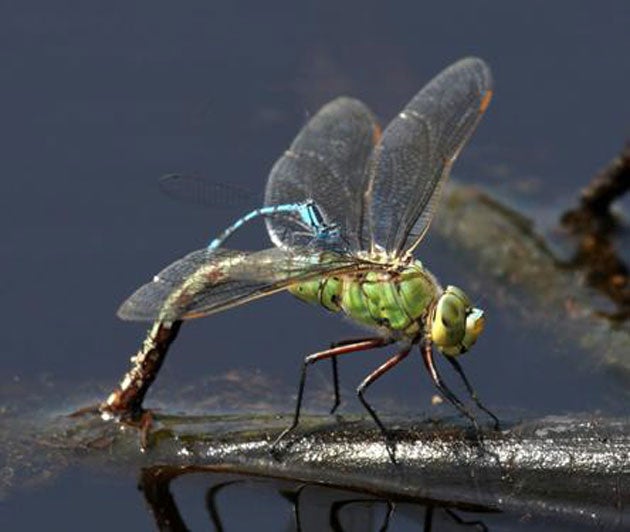Damselfly's daring landing captured on camera

It's not quite a mouse attacking an elephant. But it's in the same order of things.
This remarkable photo shows a common blue damselfly, which is dainty and charming but rather small, landing on top of a dragonfly, which is a handsome beast many times its size – in fact it's an emperor dragonfly, Britain's largest species.
What's the damselfly doing and why's it doing it? No one really knows, but this behaviour was spotted several times last week at the London Wetland Centre in Barnes, south-west London, and it appeared to irritate the dragonflies affected.
Damselflies and dragonflies, their larger relatives, mate by one landing on top of the other – they can often be seen flying around as an attached couple at this time of year – and speculation abounds as to whether this incident constitutes an attack, an attempt to hitch a ride, or a cross-species amorous advance. The latter theory is currently leading the field.
"The behaviour could be related to the ratio of the sexes in the damselfly population – if there are too many males and not enough females, the males might be desperate to mate with anything," said Martin Senior at the Wetland Centre. July is peak dragonfly and damselfly season, and the 100-acre nature reserve, run by the Wildfowl & Wetlands Trust (WWT) is a special haven for the insects, with 21 of the 42 British resident species recorded at the site. The photos were taken by Chris and Anne Algar, regular Wetland Centre visitors.
"This was one of the more unusual sights we've photographed, and we were lucky to get it because the damselflies only stayed in place for a second or so, before flying off and our equipment quit on us shortly after the photos were taken," Mr Algar said.
Join our commenting forum
Join thought-provoking conversations, follow other Independent readers and see their replies
Comments
Bookmark popover
Removed from bookmarks